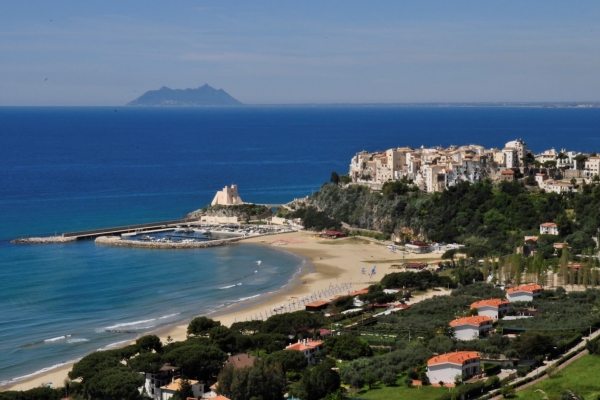The promontory from which it stands is part of the mountain range of the Aurunci Mountains, in its final stretch that extends over the crystalline waters of the Tyrrhenian Sea, in the province of Latina. All around, the area is mostly flat. In some points, the coast is very indented: rock spurs throw themselves into the sea giving life to small natural caves that give the village its name (Sperlonga derives from "spelunca", a term with which these openings overlooking the 'water).
The first traces of a human settlement in this area date back to the Paleolithic, but it was in the Roman age that Sperlonga acquired charm and beauty, thanks to the construction of numerous villas whose remains we can still admire today. During the medieval period it became a picturesque fishing village, often at the center of devastating pirate raids that destroyed it several times. The entire town was rebuilt after the seventeenth century, but there remained splendid testimonies of its more remote past.
The picturesque old town
Right in the historic center of Sperlonga we can admire what remains of its most ancient origins. At one time, the village was a real castle surrounded by fortified walls and watchtowers. Of all this remain the two access gates - Portella and Porta Marina - and three towers that stand out in the oldest heart of the town: the Truglia Tower, the Central Tower and the Torre del Nibbio (the latter two stand today right between the houses and the streets of the village). Other splendid testimonies of the past are the small churches such as the chapel of San Rocco and the church of Santa Maria di Sperlonga, dating back to 1135.
As we said above, the town still preserves marvelous works of medieval architecture, such as Palazzo Sabella (whose facade was rebuilt in the 16th century), but above all Roman. One above all is the splendid villa of Tiberius, built on the foundations of a previous late-republican structure at the behest of the Roman emperor. Its peculiarity consists in the presence of a natural cave, called the cave of Tiberius, incorporated within the villa and used as a summer dining room. Fascinating water features, extraordinary marble decorations and sculptural groups from the cycle of Ulysses were installed.
The beautiful beaches
Sperlonga, however, is not only art and culture. Its fine sandy beaches are very famous, awarded with the Blue Flag for their beauty and livability. One of the best known is the Canzatora beach, suitable for children: it rises along the western coast and is often very crowded. A little quieter are the beach of Lago Lungo, a wild area perfect for kitesurfing lovers, and that of the 300 steps. It is called this because, to reach this isolated cove, it is necessary to walk along a stepped path - accessible only for a fee.
Finally, it is impossible not to mention the Fontana beach (also known as the Sorgente beach), characterized by a small sandy cove where a small pool has formed. Inside it falls the water, sweet and very cold, which flows from the rock in the shadow of the Truglia Tower. Once this was the main source of water supply in the country, today it is a beautiful attraction.
Between art, tradition and gastronomy
What to do in Sperlonga? The possibilities are endless: in addition to spending whole days on the sand or strolling through the historic center admiring its splendid architectural works, you can enjoy some local delicacies. On the waterfront there are many restaurants where you can enjoy delicious fish dishes, but if you want to take advantage of the opportunity to discover some local specialties, all you have to do is find a restaurant. And in the evening the town comes alive, thanks to the small clubs in the historic center that offer aperitifs and good music.
Sperlonga stands on a spur of rock, the final part of the Aurunci Mountains, which extends into the Tyrrhenian Sea and the Gulf of Gaeta, merging into the Monte di San Magno.
History
In the territory there are traces of human activity starting from the upper Paleolithic.
The opening of via Litoranea Flacca, a work of daring technological innovation carried out by Prof. G. Maresca designed on behalf of the Cassa del Mezzogiorno, which runs from Terracina to Gaeta in 1958, has considerably increased the tourist flow of Sperlonga, but already the discovery , in 1957 by Prof. Giulio Iacopi, of archaeological finds and the excavation campaign of the Grotta di Tiberio, already known since 1908, were a stimulus for an ever more abundant influx of both scholars and tourists. The many hotels and other structures (a total of 39), give a great deal of hospitality which, combined with the renovation of the houses in the historic center by tourists who have become owners over time, increase in







